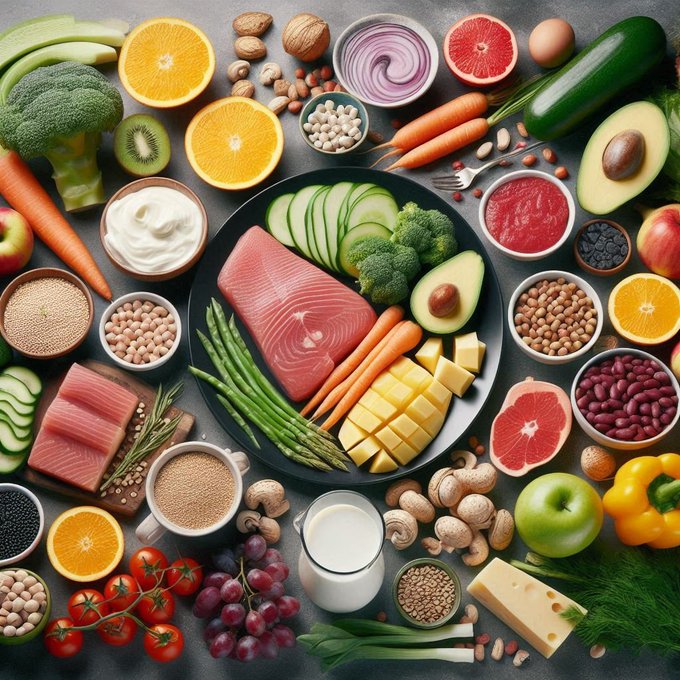What is a Flexitarian Diet?
A flexitarian diet is a flexible approach to healthy eating that focuses on incorporating more plant-based foods into your meals while still allowing for occasional consumption of meat and other animal products. The term “flexitarian” is a combination of “flexible” and “vegetarian,” highlighting the adaptable nature of this diet. Flexitarians primarily follow a vegetarian style of eating but have the flexibility to include small amounts of meat or fish when desired.
The main goal of a flexitarian diet is to increase the consumption of nutrient-rich plant-based foods, such as fruits, vegetables, whole grains, legumes, and nuts, while reducing the intake of processed and red meats. This approach offers the benefits of a vegetarian diet while still allowing for some flexibility to meet individual preferences and nutritional needs.
Key Principles of the Flexitarian Diet
The flexitarian diet is based on a few key principles that guide its approach to healthy eating. First and foremost, it encourages the consumption of plant-based foods in abundance. Fruits, vegetables, whole grains, legumes, and nuts form the foundation of a flexitarian meal plan, providing essential vitamins, minerals, fiber, and antioxidants.
Another important principle is the inclusion of moderate amounts of animal products. Flexitarians may choose to incorporate small portions of lean meats, poultry, fish, or dairy products into their meals. This allows for flexibility while still promoting a predominantly plant-based diet.
The flexitarian diet also emphasizes the importance of mindful eating. This means paying attention to hunger and fullness cues, savoring each bite, and being aware of the nutritional value of the foods consumed. Mindful eating encourages a healthier relationship with food and helps individuals make conscious choices that support their well-being.
Flexitarian vs Mediterranean Diet: A Comparison

While both the flexitarian and Mediterranean diets share similarities in their focus on plant-based foods, they have distinctive characteristics that set them apart. The Mediterranean diet is inspired by the traditional eating patterns of countries bordering the Mediterranean Sea and emphasizes consuming whole, minimally processed foods.
The flexitarian diet, on the other hand, is more flexible and allows for occasional consumption of meat and animal products. While both diets prioritize plant-based foods, the Mediterranean diet places a greater emphasis on consuming fish, olive oil, whole grains, and legumes.
The flexitarian diet offers a wider range of food choices and may be more appealing to individuals who are not ready to completely eliminate meat from their diet. It provides the flexibility to include animal products in moderation while still reaping the benefits of a predominantly plant-based eating pattern.
Benefits of Following a Flexitarian Diet
The flexitarian diet offers numerous benefits for both personal health and the environment. By increasing the consumption of plant-based foods, individuals following a flexitarian diet can enjoy improved nutrient intake. Fruits, vegetables, whole grains, and legumes are rich in vitamins, minerals, fiber, and antioxidants that support overall health and reduce the risk of chronic diseases.
Studies have shown that a flexitarian diet can help lower the risk of heart disease, high blood pressure, type 2 diabetes, and certain types of cancer. The emphasis on plant-based foods and the reduction in processed and red meats contribute to these health benefits.
Additionally, the flexitarian diet is more sustainable and environmentally friendly compared to a traditional Western diet. Animal agriculture is a significant contributor to greenhouse gas emissions and deforestation. By reducing the consumption of animal products, flexitarians can help reduce their carbon footprint and contribute to a more sustainable food system.
Flexitarian Diet Food List: What to Eat and What to Avoid

When following a flexitarian diet, it’s helpful to have a clear understanding of what foods to include and what to limit or avoid. The following is a list of foods that are encouraged on a flexitarian diet:
- Fruits: Apples, berries, citrus fruits, bananas, etc.
- Vegetables: Leafy greens, broccoli, carrots, tomatoes, bell peppers, etc.
- Whole grains: Quinoa, brown rice, oats, whole wheat bread, etc.
- Legumes: Lentils, chickpeas, black beans, soybeans, etc.
- Nuts and seeds: Almonds, walnuts, chia seeds, flaxseeds, etc.
- Plant-based proteins: Tofu, tempeh, seitan, edamame, etc.
- Dairy products (optional): Greek yogurt, cottage cheese, etc.
- Lean meats and fish (in moderation): Chicken, turkey, salmon, etc.
It’s important to limit the consumption of processed meats, such as bacon, sausage, and deli meats, as they are high in sodium and unhealthy additives. Red meats, such as beef and pork, should also be consumed sparingly. By prioritizing plant-based foods and incorporating moderate amounts of lean meats and fish, individuals can create a balanced and nutritious flexitarian meal plan.
Tips for Transitioning to a Flexitarian Diet
Transitioning to a flexitarian diet can be a gradual process, and it’s important to approach it at your own pace. Here are some tips to help you make the transition smoothly:
- Start by adding more plant-based foods to your meals. Gradually increase the portions of fruits, vegetables, whole grains, and legumes while reducing the amount of meat on your plate.
- Experiment with new recipes and flavors. Explore different cuisines that focus on plant-based ingredients and find recipes that excite your taste buds.
- Plan your meals ahead of time. This will help you incorporate a variety of plant-based foods and ensure that you have all the necessary ingredients on hand.
- Find alternatives to your favorite meat-based dishes. There is a plethora of plant-based substitutes available, such as tofu, tempeh, and seitan, that can provide a similar texture and taste.
- Be open-minded and flexible. Allow yourself to enjoy occasional meat-based meals or special treats without guilt. Remember, the flexitarian diet is all about finding a balance that works for you.
By taking small steps and gradually incorporating more plant-based foods into your diet, you can successfully transition to a flexitarian lifestyle.
Flexitarian Diet Recipes and Meal Ideas
Here are some delicious and nutritious flexitarian recipes and meal ideas to inspire your culinary journey:
- Quinoa and Black Bean Salad: Cook quinoa and mix it with black beans, diced bell peppers, cherry tomatoes, corn, and a tangy lime dressing for a refreshing and protein-packed salad.
- Baked Falafel Wraps: Make homemade falafel using chickpeas, herbs, and spices. Serve them in whole wheat wraps with fresh veggies and a drizzle of tahini sauce.
- Veggie Stir-Fry: Sauté a variety of colorful vegetables like broccoli, bell peppers, carrots, and snap peas in a flavorful sauce made with soy sauce, garlic, and ginger. Serve over brown rice or quinoa.
- Lentil Bolognese: Replace the traditional meat sauce with a hearty lentil-based version. Cook lentils with onions, garlic, tomatoes, and herbs for a delicious and fiber-rich pasta topping.
- Roasted Vegetable Buddha Bowl: Roast a mix of vegetables like sweet potatoes, Brussels sprouts, and cauliflower. Serve over a bed of quinoa or brown rice and top with avocado, chickpeas, and a drizzle of tahini dressing.
These are just a few examples of the endless possibilities when it comes to flexitarian cooking. Get creative in the kitchen and enjoy exploring the flavors and versatility of plant-based ingredients.
Flexitarian Diet and Weight Loss: Can it Help You Shed Pounds?

The flexitarian diet can be an effective approach for weight loss due to its emphasis on nutrient-dense, low-calorie foods. By increasing the consumption of fruits, vegetables, whole grains, and legumes, and reducing the intake of high calorie processed and red meats, flexitarians can create a calorie deficit that promotes weight loss.
Plant-based foods are generally lower in calories and higher in fiber compared to animal products, which can help increase satiety and reduce overall calorie intake. The high fiber content of a flexitarian diet also aids in digestion and promotes a healthy gut microbiome.
In addition to the calorie aspect, the flexitarian diet encourages mindful eating, which can help individuals develop a healthier relationship with food and reduce emotional or mindless eating habits. By being more aware of hunger and fullness cues, individuals can make conscious choices that support their weight loss goals.
However, it’s important to note that weight loss is a complex process that depends on various factors, including individual metabolism and overall calorie balance. While the flexitarian diet can be a helpful tool for weight loss, it should be combined with regular physical activity and a balanced lifestyle for optimal results.
Flexitarian Diet and the Environment: How it Contributes to Sustainability
The flexitarian diet is not only beneficial for personal health but also for the environment. Animal agriculture, particularly the production of meat and dairy products, is a significant contributor to greenhouse gas emissions, deforestation, and water pollution.
By reducing the consumption of animal products, flexitarians can help reduce their carbon footprint and contribute to a more sustainable food system. Plant-based foods require fewer natural resources, such as land, water, and energy, compared to animal products. Additionally, the production of plant-based foods generates fewer greenhouse gas emissions, making them a more environmentally friendly choice.
The flexitarian diet promotes a shift towards a more plant-centric eating pattern, which can help conserve natural resources, protect biodiversity, and mitigate climate change. By making conscious choices about the foods we consume, we can contribute to a more sustainable future for ourselves and future generations.
Incorporating Exercise with a Flexitarian Diet for Optimal Health

While the flexitarian diet provides a solid foundation for overall health, incorporating regular exercise is essential for optimal well-being. Physical activity helps maintain a healthy weight, strengthens muscles and bones, reduces the risk of chronic diseases, and improves mental well-being.
To complement a flexitarian diet, individuals should aim for a combination of cardiovascular exercise, strength training, and flexibility exercises. Cardiovascular activities, such as brisk walking, running, cycling, or swimming, help improve heart health and burn calories. Strength training exercises, such as weightlifting or bodyweight exercises, build lean muscle mass and increase metabolism. Flexibility exercises, such as yoga or stretching, improve joint mobility and enhance overall flexibility.
Finding activities that you enjoy and incorporating them into your daily routine can help make exercise a sustainable habit. Whether it’s joining a fitness class, going for a hike, or dancing to your favorite music, finding ways to stay active will complement the health benefits of a flexitarian diet and contribute to your overall well-being.
Conclusion: Embracing a Flexible Approach to Healthy Eating with the Flexitarian Diet
The power of the flexitarian diet lies in its flexible approach to healthy eating. By incorporating more plant-based foods into your meals and reducing the consumption of processed and red meats, you can enjoy the benefits of a predominantly plant-based diet while still allowing for occasional indulgences.
The flexitarian diet offers numerous advantages, including improved nutrient intake, reduced risk of chronic diseases, weight management, and environmental sustainability. By prioritizing fruits, vegetables, whole grains, legumes, and nuts, individuals can ensure a well-balanced diet that supports their overall health and well-being.
Remember, transitioning to a flexitarian lifestyle is a personal journey that can be approached at your own pace. Start by incorporating more plant-based foods into your meals and experiment with new recipes and flavors. Be open-minded, flexible, and mindful of your choices.
Embrace the power of the flexitarian diet and enjoy the benefits of a flexible approach to healthy eating. Your body, mind, and the planet will thank you.


